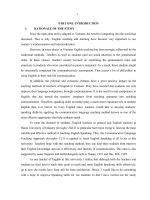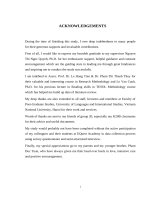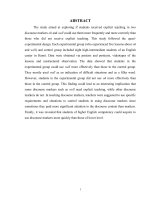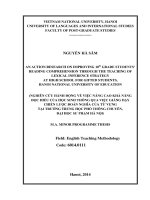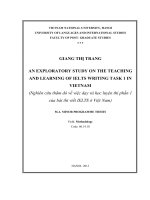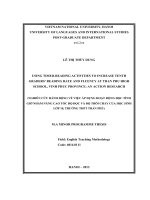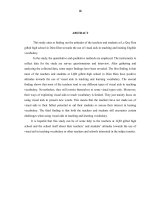Nghiên cứu thăm dò về việc dạy và học phần đọc hiểu TOEIC tại EQuest academy
Bạn đang xem bản rút gọn của tài liệu. Xem và tải ngay bản đầy đủ của tài liệu tại đây (714.89 KB, 74 trang )
ACKNOWLEDGEMENTS
During the time of finishing this study, I owe deep indebtedness to many people
for their generous supports and invaluable contributions.
First of all, I would like to express my heartfelt gratitude to my supervisor Nguyen
Thi Ngoc Quynh, Ph.D. for her enthusiastic support, helpful guidance and constant
encouragement which are the guiding stars in leading me through great hindrances
and inspiring me to conduct the study successfully.
I am indebted to Assoc. Prof. Dr. Le Hung Tien & Dr. Pham Thi Thanh Thuy for
their valuable and interesting course in Research Methodology and Le Van Canh,
Ph.D. for his precious lecture in Reading skills in TESOL Methodology course
which has helped me build up data of literature review.
My deep thanks are also extended to all staff, lecturers and members at Faculty of
Post-Graduate Studies, University of Languages and International Studies, Vietnam
National University, Hanoi for their work and services.
Words of thanks are sent to my friends of group 20, especially my K20B classmates
for their advice and useful documents.
My study would probably not have been completed without the active participation
of my colleagues and their students at EQuest Academy in data collection process
using survey questionnaire and semi-structured interview.
Finally, my special appreciations go to my parents and my younger brother, Pham
Duc Tuan, who have always given me their head over heels in love, intensive care
and positive encouragement.
i
ABSTRACT
This study was conducted to find out (1) what problems EQuest Academy (EQ)
teachers and EQ students had in the teaching and learning to prepare for TOEIC
reading comprehension skills (part 7). Furthermore, (2) the teachers and students’
perspectives s on the strategies which they had employed were expected to be
discovered.
In order to obtain the intended goal, 90 students of TOEIC class and 15 teachers in
charge of TOEIC course undertook the data collection method of questionnaires and
interviews. The findings figured out that length of the reading texts and
their unfamiliar topics caused the teachers more trouble compared with the students
whereas unknown words and complex structures hindered the students more than
the teachers. The results from the students were remarkably consistent with Dao
(2007) at Le Hong Phong high school. More strikingly, vocabulary was perceived
as the biggest hindrance by both EQ teachers and students in reading
comprehension as found in Yorio (1971) and Vu (2010)’s paper. The other top
problems consisted of the lack of skills relating to guessing new words in the
contexts and the students’ infrequent participation in the in-class reading lessons.
Regarding their strategies, surprisingly, the large number of TOEIC learners did not
sound well-prepared before lessons in the class in term of doing homework or
asking the teachers for the outside classroom supplementary materials. Besides, the
TOEIC trainers put much more emphasis on interactive approach than the TOEIC
learners.
Based on the findings, several pedagogical suggestions for further exploitation were
offered for both the teachers and the students in EQuest Academy to improve the
current situation of the teaching and learning of TOEIC reading comprehension.
TABLE OF CONTENTS
ii
DECLARATION I
ACKNOWLEDGEMENTS II
ABSTRACT III
TABLE OF CONTENTS IV
LIST OF TABLES AND CHARTS VII
ABBREVIATIONS VIII
PART I: INTRODUCTION 1
1. The statement of the problem and the rationale for the study 1
2. Research aims and research questions 2
3. Scope of study 2
4. Method of study 3
PART II: DEVELOPMENT 4
CHAPTER 1: LITERATURE REVIEW 4
1.1. Reading 4
1.1.1. Definition of reading 4
1.1.2. Reading process 5
1.1.3. The teaching and the learning of reading 6
1.2. TOEIC 6
12.1. TOEIC definition, origin, benefit and topic 6
1.2.2. TOEIC reading 8
1.2.2.1. TOEIC reading background 8
1.2.2.2. Some factors affecting the teaching and learning of TOEIC reading
comprehension skills 11
1.2.2.3. TOEIC reading comprehension strategies 11
CHAPTER 2: METHODOLOGY 13
2.1. Setting 13
2.2. Research design 13
2.2.1. Participants 13
2.2.2. Data collection 14
iii
2.2.2.1. Instruments 16
2.2.2.2. Procedure 16
2.2.2.3. Data analysis 17
CHAPTER 3: RESULTS AND DISCUSSION 19
3.1. Research question 1 19
3.1.1. Perceptions about difficult reading text 19
3.1.2. Areas of difficulties 20
3.1.3. Reading skills 23
3.1.4. The students’ performance in class 25
3.1.5. Difficulties with the teachers’ lecture 27
3.2. Research question 2 28
3.2.1. Types of reading texts often exploited 28
3.2.2. Strategies before TOEIC reading comprehension lessons 30
3.2.3. Reading approach 32
3.2.4. Priority of reading passages 34
3.2.5. Teacher’s advice to deal with reading text 36
3.2.6. Learners’ strategies to deal with reading text 38
PART III: CONCLUSION 40
1. Major findings of the research 40
2. Pedagogical suggestions for a more effective exploitation of
reading comprehension in Equest Academy 43
2.1. For students 43
2.2. For teachers 44
3. Limitations of the research 46
4. Suggestions for further studies 47
REFERENCES 48
APPENDIXES 53
Appendix 1: Survey questionnaire for students
(Vietnamese+ English version) 53
iv
Appendix 2: Survey questionnaire for teachers
(Vietnamese and English version) 57
Appendix 3: Plan for semi-structured interview questions 61
Appendix 4: The flyer “Khóa luyện thi TOEIC” 62
Appendix 5: Sample of TOEIC reading session parts 63
Appendix 6: Reading strategies from Longman preparation series for
the TOEIC test: Intermediate course 66
LIST OF TABLES AND FIGURES
Table 1: TOEIC topics 8
v
Table 2: TOEIC reading comprehension structure 10
Table 3: Teachers’ difficulties with the students’ performance in class 25
Table 4: Students’ difficulties with the lecturers’ lecture 27
Table 5: Teachers and students’ types of reading texts often exploited 28
Table 6: Teachers’ advice to deal with reading text 36
Table 7: Learners’ strategies to deal with reading text 38
Figure 1: Teachers and students’ perception about difficult reading 19
Figure 2: Teachers and students’ areas of difficulties 20
Figure 3: Teachers and students’ difficulties with reading skills 23
Figure 4: Teachers and students’ strategies before TOEIC reading
comprehension lessons 30
Figure 5: Teachers and students’ exploitation of reading approach 32
Figure 6: Teachers’ and students’ reponses related to priorty of
reading passages 34
Figure 7: Teachers’ and students’ reasons for reading single passages first 34
ABBREVIATIONS
& and
vi
EQ EQuest Academy
p page
T Teacher
TOEIC Test of English for International Communication
vii
PART I: INTRODUCTION
1. The statement of the problem and the rationale for the study
Recently, in Vietnam, learning foreign languages especially English has been
taken more notice as a result of intense and extensive world economic integration
which occurs in a “flat, hot and crowed” world as the present (Friedman, 2008).
Noticeably, in such a competitive global economy, those who achieve an excellent
level of using English are highly well-qualified for good jobs. The TOEIC test,
regarded as the worldwide standard for measuring English proficiency in the
workplace, is a leading factor into “(1) screen[ing] employees for overseas
business trips or postings; (2) urg[ing] workers to make greater efforts to learn
English; and (3) asses[ing] the effectiveness of company-sponsored English
training programs” (The Daily Yomiuri, 1997, p. 9 cited in Karn & Forster, 1998,
p.3). Therefore, the success in the TOEIC test seems to be a mandatory
requirement for the majority of successful job candidates.
In the report “[l]earn about TOEIC test-taker worldwide” by Educational Testing
System (2011, p.2), 30% TOEIC test-takers chose reading as the most frequently-
used English language skill. It can be inferred that TOEIC reading is popular in
daily lives or working environment among TOEIC examinees.
As the teacher of TOEIC course training in EQuest Academy (EQ), the researcher
realizes that TOEIC reading comprehension (part 7) has been a heated topic
discussed not only among the teachers in EQuest Academic Department but also
TOEIC learners in EQuest Academy for a long period of time but there has not
been any paper which collects and synthesizes the difficulties and strategies from
the EQuest trainers and learners in order to make the learning and teaching of
TOEIC reading comprehension better. Furthermore, except for the study by
Nguyễn Thị Yến (2010) on “difficulties in teaching TOEIC speaking skills” and
the research by Nhữ Hà Phương (2012) on “the common errors in the TOEIC
listening test”, it appears that no thesis paper about the issues relating to TOEIC
1
reading comprehension in the post-graduate faculty’s library may has been carried
out. For the two main reasons stated above, it is very necessary and urgent to
conduct a study with the title “[a]n exploratory study on the teaching and
learning of TOEIC Reading Comprehension skills at EQuest Academy”.
2. Research aims and research questions
Firstly, the study is conducted to find out what difficulties EQ students have had
when practicing TOEIC Reading Comprehension to prepare for the TOEIC test
and EQ teachers’ problems in teaching TOEIC Reading Comprehension.
Secondly, their (teachers and student’s) viewpoints on the strategies which they
have employed are expected to be detected. In specific, a detailed investigation is
carried out to specify the strategies EQ students have used during the process of
reading comprehension and the strategies EQ teachers have employed in the
process of teaching. In brief, this study aims to address two following research
questions:
1. What are the difficulties encountered by teachers and students at EQuest
Academy in the teaching and learning to prepare for the TOEIC reading
comprehension test?
2. What are the strategies proposed by teachers and students at EQuest
Academy towards the teaching and learning to prepare for the TOEIC
reading comprehension test?
3. Scope of study
Despite the fact that the topic is about “[a]n exploratory study on the teaching and
learning of TOEIC Reading Comprehension skills at EQuest Academy”, the
researcher only concentrates on a few aspects of the teaching and learning of
TOEIC Reading Comprehension skills namely the difficulties in learning, the
difficulties in teaching, the strategies in learning and the strategies in teaching.
The samples of the study were, due to the time limitation and the small scale of
research, restricted to 90 EQ students in 373 Hoang Quoc Viet, in 55 Nguyen
2
Khang and on 2
nd
floor of HESCO Building, Km 10 Nguyen Trai. At the same
time, 15 EQ teachers were involved in the research.
4. Method of study
To address the two research questions presented above, a combined data
collection process using survey questionnaire and semi-structured interview had
been used.
Survey questionnaire consisting of two sets of questionnaire (a set for students and
the other is for teachers) was employed to collect information from 90 EQ
students and 15 EQ teachers. They were offered to tick or circle the answer that
best reflects their viewpoints. Besides closed-ended questions, open-ended ones
were also exploited so that the students could specify any additional comments on
the situations given.
Next, semi-structured interviews were conducted. 23 interviewees (15 EQ students
and 8 EQ teachers) who had taken part in the questionnaire provided in-depth
information about their viewpoints in the questionnaire. With the aim of making
the respondents most confident in the interview, the used language was
Vietnamese. Noticeably, typical statements from 23 interviews recorded with the
respondents’ permission were taken advantage to represent the arguments in the
chapter “Results and Discussion”.
3
PART II: DEVELOPMENT
CHAPTER 1: LITERATURE REVIEW
1.1. Reading
1.1.1. Definitions of reading
“The best way to improve one's knowledge of a foreign language is to go and live
among its speakers. The next best way is to read extensively in it.” (Nuttall, 1982,
p.168). It is undeniable that reading in general and extensive reading in particular,
as Nuttall states, of great importance in learning a foreign language. Regarding
reading definition, it can be described differently by a variety of scholars.
As stated by Williams (1986, p.2), reading is “a process whereby one looks at and
understands what has been written”.
Anderson (1999, p.1) argues that “[r]eading is an active, fluent process which
involves the reader and the reading material in building meaning.”
Both Williams (1986) and Anderson (1999) point out that reading is a cognitive
process whereby the reader decodes the text so as to (re)create meaningful
discourse.
Holding the similar opinion with William and Anderson, Goodman (1971, p. 153)
asserts that reading is “a psycholinguistic process by which the reader- a language
user, reconstructs, as best as he can, a message which has been encoded by a
writer as a graphic display.”
In a nutshell, the researcher is in favor of Goodman (1971) that reading can be
described as the process including the reader, the text and the meaning which is
transferred from the writer to the reader via the text.
Regarding reading comprehension, Roe, Stoodt & Burns (1987) regard it as
“reconstruction, interpretation, and evaluation of what author of written content
means by using knowledge gained from life experience” (p.9). RAND Reading
Study Group (2002) is in agreement with Roe, Stoodt & Burns but in the other
4
words that reading comprehension is “the process of simultaneously extracting
and constructing meaning through interaction and involvement with written
language” (p.11). It is constituted by the three components: the reader, the text and
the activity of purpose for reading. The purpose for reading will be an important
factor in reading comprehension. For instance, a person who is wondering whether
she/he has enough money to go on vacation in Ha Long Bay needs to comprehend
the price information provided on the travel package, but does not need to realize
the name of every site in Ha Long Bay and service involved.
Lee & VanPatten (1995) add that only when novel information is integrated into
information already stored in memory will comprehension occur (p.191). They go
on to allege that readers are capable of allowing the incoming data to “become a
part of their knowledge store” (p.191).
1.1.2. Reading process
Two main reading processes include “the top-down approach” and “the bottom-up
approach” (deDebat, 2006, p.8). While the top-down process focuses on a reader’s
“background knowledge” (or knowledge and the previous experiences) to
understand a written text, the later emphasizes “decod[ing] a text word by word,
linking the words into phrases and then sentences” (Gray & Rogers, 1956, cited in
deDebat, 2006, p.9)
As deDebat (2006, p.10) states, the top-down process is closely related to “schema
theory” which is explained by Nunan (1999) as the notion of “the creation of
mental frameworks that help us make sense of new experiences” (p.201) from the
previous experiences. Kucer (1987, p.31), Anderson (1994, p.469) and Anderson
& Pearson (1988, p.38) go on to add that the prior experiences may involve
knowledge about the text structure or knowledge about the subject matter of a
text.
Additionally, Eskey (1988) assures that interactive reading is “a constant
interaction between bottom-up and top-down processing in reading, each source of
5
information contributing to a comprehensive reconstruction of the meaning of the
text” (p.94). It can be elucidated that the interactive reading combines both
bottom-up and top-down approaches. Eskey continues to reveal that so as to
become a good reader; developing reader must be in the perfection of “bottom-up
recognition skills and top-down interpretation strategies” (p.94) without which the
readers can not succeed in reading comprehension.
1.1.3. The teaching and the learning of reading
According to Brown (1994), the teaching of reading consists of three steps: pre-
reading discussion, while-reading task, post-reading exercises. In the post-reading
step, in-depth discussions about the author’s reasoning or summary-writing related
assignment are highly exploited by teachers.
“If teachers understand the nature of reading comprehension and learning from a
text, they will have the basis for evaluating and improving learning environment”
(Tierney & Pearson, 1994, p.496)
According to Lee & Mallinder (2011, p.155), it is better for students to be trained
basic reading skills such as “scanning, skimming, guessing, note-taking,
summarization, referring to the contexts, repeated reading” before extensive
reading practice because there is a strong link between the reading skills and the
rapid completion of reading passages’ questions.
As stated by Dhieb-Henia (2006), reading strategies may be exploited successfully
due to the student’s consciousness of the reading strategies and ability to use them
flexibly which are based on the task’s purpose and solving-problem (p.4).
1.2. TOEIC
1.2.1. TOEIC definition, origin, benefit and topic
Firstly, in the research report of Educational Testing System, Test of English for
International Communication (TOEIC) is “multiple-choice” proficiency test which
is built to measure communicative English for “nonnative-English speakers”
(Wilson, 2000, p.1).
6
Furthermore, as Boldt & Ross (1998, preface) announce, in world-wide business
settings, TOEIC is regarded as “the world’s leading test of English language
proficiency” with the number of 1.5 million test-takers in 1997 (Boldt & Ross,
1998, preface). Obviously, TOEIC places a crucial role in the setting of global
economy as an international assessment tool of communicative English in the
workplace.
Secondly, regarding the origin of TOEIC, Test of English for International
Communication was built by ETS (Educational Testing Service) from the originally
proposed request by Japanese Ministry of International Trade and Industry (Suzuaki
& Daza, 2004, p.16). In the TOEIC Report on Test-takers worldwide, Japan and
Korea were two countries which TOEIC test results were the most popularly
exploited (63% and 29% respectively) (cited in Suzuki & Daza, 2004, p.16).
Thirdly, in term of TOEIC benefits, the test is considered a golden key to
unlock the door into “job recruitment” as well as “admission to graduate
schools” (Kamijo, n.d, p. 174). According to Boldt & Ross (1998, p.3),
English language proficiency is a primary priority of many international
incorporations when they make up their mind about “hiring, overseas
staffing, placement and career advancement” (p.3)
In a review of the reading section of the TOEIC, Suzuki & Daza (2004)
argues that TOEIC can be employed by many corporations for different
purposes such as “(a) technical training in English; (b) overseas
assignments; and (c) language training” (p.16). Furthermore, TOEIC can be
conducted for “formative or placement purposes” (p.16) or provide students
with scholarships in Japan or Korea.
Lastly, as presented in Examinee handbook-listening & reading (2012, p.3),
TOEIC covers some topics as follows:
7
Topics Details
Corporate development research, product development
Dining out business and informal lunches, banquets, receptions,
restaurant reservations
Entertainment cinema, theatre, music, art, exhibitions, museums, media
Finance and budgeting banking, investments, taxes, accounting, billing
General business contracts, negotiations, mergers, marketing, sales,
warranties, business planning, conferences, labor relations
Health medical insurance, visiting doctors, dentists, clinics,
hospitals
Housing/corporate
property
construction, specifications, buying and renting, electric
and gas services
Manufacturing assembly lines, plant management, quality control
Offices board meetings, committees, letters, memoranda, telephone,
fax and e-mail messages, office equipment and furniture,
office procedures
Personnel recruiting, hiring, retiring, salaries, promotion, job
applications, job advertisements, pensions, awards
Purchasing shopping, ordering supplies, shipping, invoices
Technical areas electronics, technology, computers, laboratories and related
equipment, technical specifications
Travel trains, airplanes, taxis, buses, ships, ferries, tickets,
schedules, station and airport announcements, car rentals,
hotels, reservations, delays and cancellations
(Examinee handbook-listening & reading, 2012, p.3)
Table 1: TOEIC topics
1.2.2. TOEIC reading
1.2.2.1. TOEIC reading background
It has been popularly known that TOEIC Listening and Reading is a 120-minute
paper-and-pencil test which includes two sections: listening section and reading
section. There are 100 multiple-choice questions in reading section which takes
75 minutes. Reading score scale ranges from 5 to 495 and the total score scale
(both reading and listening) ranges from 10 to 990 (Examinee handbook-
listening & reading, 2012, p.2).
8
Reading section covers three parts (part 5, part 6 and part 7 in total TOEIC test)
and instructions provided for each part. Regarding part 5, 40 questions are
presented to test TOEIC learners’ grammar and vocabulary extensively. Below
each sentence with a blank which needs to be filled out with a word or phrase are
four options marked (A), (B), (C) and (D). A typical example is taken from
[e]xaminee handbook-listening & reading (2012, p.12) as follow:
101. A late fee will be applied to your account _______
payment is not received by March 31.
(A) and (B) whether (C) but (D) if”.
For this sample question, the answer (D) is the best choice, so the examinees
should mark the letter (D) on their answer sheets with the pencils supplied by IIG
Vietnam. As recommended by Lougheed (2007), so as to do such forty-question
task effectively, the examinees should be trained with “word families, similar
words, prepositions, conjunctions, adverbs of frequency, causative verbs,
conditional sentences, verb tense and two-word verbs” (p.108)
Part 6 is basically similar to part 5 in the form of question. Accordingly, the test-
takers are also required to complete each sentence with a word or phrase which is
represented by (A), (B), (C) and (D). There are two dissimilar things between part
6 and part 5. The first difference is the number of questions, while 40 questions of
reading session are contributed to part 5, only part 6 is constituted of 12 questions.
Additionally, the fifth part consists of forty separate sentences but the sixth part
includes three or four questions for each text. It can be understood that only three
or four texts are seen in the test paper given for part 6 (see more in the appendix 5)
Concerning part 7 (reading comprehension), the test attendants will read a
selection of texts and answer some questions below each text. According to ETS
(Educational Testing Service) (2012, p.13), part 7: reading comprehension
requires test-takers to read a variety of texts which are, as Wilson (2000) lists,
9
constituted by “manuals, reports, forms, notices, advertisements, periodicals,
memorandum, letters, news and magazine articles” (cited in Kamijo, n.d., 173)
As Muller (2007) assures, there exist four main text structures/patterns in TOEIC
reading passages, namely “problem/solution, general/specific, claim/counterclaim
and question/answer” (p.36). Muller goes on to allege that when students have
profound insight into passage components, they could find the answer to test
question very quickly because they are conscious of where they may look for, “at
the beginning, middle or end of the passage” (p.52).
Reading comprehension section (part 7) is constituted by single passages and
double passages. Single passages contain 28 questions (153-180). Test-takers will
only read each advertisement, form, letter, e-mail, fax, memo, table, index, chart,
instruction, or notice separately. There are at least 2 questions and a maximum of
4 questions for each single passage.
Unlike single passage, double passages will cover a set of two passages. Test-
takers might read an email and a memo; a form and a fax; a table and a letter; a
letter and a letter. Double passages have the five questions for each set of two
passages. In summary, as presented in Longman Preparation Series for the
TOEIC Test: Introductory course, the structure of TOEIC reading comprehension
may be summed up as follows:
Part 7
Sections
Number of
questions
Number of
Passages
Questions Question
numbers
Single passages 28 7-10 2-4 per passage 153-180
Double passages 20 4 pairs 5 per pair of passages 181-200
(Lougheed, 1996b, p.150)
Table 2: TOEIC reading comprehension structure
1.2.2.2. Some factors affecting the teaching and learning of TOEIC
reading comprehension skills
10
As stated in TOEIC research report #3 by the Chauncey Group International Ltd,
class size is classified into 3 groups: small (under 10 learners), medium (10-20
learners) and large (more than 20 learners) (p.5).
Some factors impacting the success of acquiring language may involve “learning
materials, the background of the instructors, objects of the training course, the
number of students in the class” besides students’ factors such as “motivation, age
and time spent in an English-speaking country” (Boldt & Ross, 1998, p. 3)
The interesting finding by Chujo & Oghigian (2009) shows that “in order to gain
95 percent coverage on TOEIC, a reader would need a minimum vocabulary size
of 4,000 words or 3, 000 word families” (p.121)
1.2.2.3. TOEIC reading comprehension strategies
Lougheed (2007b) suggests that reading skills such as “skimming, scanning, using
the context and reading fast” (p.227, see more in the 6
th
appendix) should be
practiced sharply to enhance reading comprehension. He goes on to add that a
competitive tip is to “read the questions before [test-takers] read the passage”
(Introductory Course, p.151). It might be inferred that when readers have a
particular question in their mind, they can read fast and purposefully.
Furthermore, TOEIC examinees “do not read the answer before [they] read the
passage” (Lougheed, 2007a, p.151). It may be understood that when test-takers
master each reading question, they should find the answer in the passage instead
of looking for answer options (A), (B), (C) or (D) after each question. Noticeably,
Lougheed (2007c) reveals that TOEIC examinees should find not only direct
answers but also “synonyms, paraphrases, and implied answers” (p.170). It is not
enough without mentioning four main question types-“main idea questions, detail
questions, inference questions and vocabulary questions” (Lougheed, 2007a,
p.151) which readers are highly recommended to prepare for the new TOEIC test.
Forster et al. (1997, p.129) continue to reveal that reading the questions with
carefulness is the first step followed by predicting possible correct answers. The
11
second step comes to information-identifying skills which. In “Strategies 1:
Building TOEIC/TOEFL test-taking skills”, it is pointed out that the questions
asked may not impose as the orderly information in the text. Additionally, from
the my teaching experience, I am in agreement with such researchers in term of
wrong answers in TOEIC reading comprehension which may be resulted in by
choosing “too general, too vague or too specific” answers (p.129)
As Forster et al. (1997, p.9) recommend, answers B and C are the two most
popular answers to questions in TOEIC, so it is worthy to advise students to mark
B or C when they have no idea for the answer to a specific question. Moreover,
these researchers suggest that when students encounter a new word which they
have not seen before, it is better to depend on surrounding words in the sentences
for guessing the new word in the context.
CHAPTER 2: METHODOLOGY
2.1. Setting
12
EQuest Academy where the researcher has been teaching TOEIC for 2 years is
one educational organization which highly majors in educating students or
workforce to take English standardized tests such as TOEFL iBT (Test Of English
as a Foreign Language), IELTS (International English Language Testing System)
and TOEIC (Test of English for International Communication). Among these
training courses, TOEIC course (see appendix 4) attracts a lot of students from big
universities in Hanoi namely Hanoi University of Commerce, Institute of Finance,
Hanoi University of Industry or Foreign Trade University to take part in this
course. To meet requirements for a TOEIC course, students should be at pre-
intermediate level of English in order to catch up with advanced curriculum. Some
students whose English is not good enough to attend in TOEIC course will have to
join the lower proficiency course called Foundational Academic Course (FAE). In
FAE course, students will be provided with input knowledge such as more
vocabulary, grammar and sentence structures to improve their four skills including
speaking, listening, reading and writing to prepare for next higher course TOEIC
course.
2.2. Research design
2.2.1. Participants
In accordance with ETS statistics, TOEIC test-takers in 2010 were comparatively
young. 40% were between 21 and 25 years old while 23% were at younger age,
below 20 years old (ETS, 2011, p.8). The students registering for in-2013-TOEIC
course in EQuest Academy seemed to be younger than those from ETS statistics
from different regions worldwide. The in-the-research-Equest students’ ages
ranged from 19 to 27 with different kinds of occupations. About 85% were
between 21-25 years old. They were third year or fourth year students who wanted
to have better skills for TOEIC in preparation for the-inside-house TOEIC at their
school. About one-third of participants aged 21-25 had graduated from their
schools for about 1 year but still out of employment.
13
The number of participants in the study was 90 who had been chosen randomly
from 5 TOEIC preparation classes in EQuest Academy. They had learned TOEIC
from 2 to 7 month(s). Some of them were pre-intermediate level of English. Most
of the participated students had already attended TOEIC preparation courses while
others had already been trained reading skills in TOEIC reading comprehension.
15 teachers were also invited to participate in the survey. The majority of EQuest
teachers were very young, from 22 to 25. They had already graduated from Hanoi
University of Languages and International Studies, Hanoi University or Banking
Academy and National University of Education for 1 to 3 years and become
EQuest teachers for 6 months till 2 years. Before teaching TOEIC, the teachers
had taught Foundational Academic Course and upgraded their vocabulary,
grammar and listening, speaking, reading and writing skill to have high capacity
for TOEIC preparation course. 5 of EQuest teachers achieved more than 900
points for the real TOEIC exam held in IIG Vietnam, 4 teachers obtained more
than 850 points and others were both encouraged and obligated to sit for TOEIC
exam due to the end of 2013. In the study, 66.67% teachers were in charge of
TOEIC B and 33.33% teachers were training TOEIC A students.
2.2.2. Data collection
2.2.2.1. Instruments
For the purpose of collecting sufficient, reliable and valid data for the study, and
questionnaire and interviews were fully employed.
Two questionnaires were employed, one of which was for the students who had
finished TOEIC course (see appendix 1) and the other one for EQuest teachers
who specialized in training this course (see appendix 2). In order to help
participants understand the two questionnaires completely, Vietnamese was
preferentially used.
Regarding the teachers’ questionnaire, brief introduction about the researcher and
the thesis’s topic was given at the beginning of the starting page. Eleven questions
14
involve both closed-ended questions and open-ended questions with spaces for
clarifying answers or adding additional comments. Such eleven questions are
classified into two parts, each part corresponding to one research question. The
first four questions were related to difficulties encountered by Equest TOEIC
teachers in teaching. The difficulties were categorized under the headings namely
(1) perceptions towards difficult reading texts”, (2) areas of difficulties in
teaching, (3) reading skills with much trouble in teaching and (4) the students’
performances causing the teachers’ teaching less efficient. The second part from
the 5
th
question till the 11
th
question was concerned about the strategies proposed
by Equest teachers. Noticeably, the 7
th
question about reading approach which the
teachers trained students in TOEIC reading comprehension was noted with three
key terms followed by Vietnamese brief explanation to avoid possible
misunderstanding which might lead to inaccuracy of the results later on.
Concerning the 8
th
question, the teachers in the research were asked about their
experience and advice in choosing whether single passages or double passages
should be read first to obtain highly practical effectiveness. The two follow-up
questions were designed to uncover the convincing reasons from the teachers’
recommendations as stated in the 8
th
question.
The students’ questionnaire was similar to the teachers’ questionnaire. It also
covered closed ended questions and open-ended questions. In fact, the number of
questions for the students was the same as the quantity of questions for the
teachers but from different perspective because the researcher would like to
collect the contrastive viewpoint from both the students and the teachers on each
issue.
Like the questionnaires, two separated interview schedules (see appendix 3) were
arranged for both the students and the teachers. Different from the questionnaires,
open-ended questions were mainly utilized in the interviews for the purpose of
obtaining the in-depth information. Before conducting interviews, the researcher
wrote out a list of questions necessitated to ask after re-reading the participants’
15
questionnaire. Such prepared questions were expected “to provide the interviewer
with a great deal of flexibility while offering the interviewees adequate power and
control over the course of the interview” (Vu, 2006, p.35). Accordingly, 15
students and 8 teachers were interviewed to further know about their answers,
regarding kinds of reading passages, reasons for reading single or double passages
first, areas of difficulties, their perceptions about difficult reading passages and
their strategies in TOEIC reading comprehension. Strategically, the questions in
the semi-instructed interview between the researcher and the respondents were
brought up naturally which helped collect the data efficiently because the
interviewees felt relaxed and could answer honestly.
2.2.2.2. Procedure
The process of data collection was categorized into three major stages as follows.
Stage 1
The first step was to prepare for collecting the data, which covered designing two
questionnaires for the Equest teachers and Equest students and giving two lists of
semi-structured questions. Importantly, the first draft of questionnaire and
interviews were piloted with five students and two two-year-experience teachers,
the result of which were seriously considered to redesign for the final draft. For
instance, thanks to the pilot process, the introduction of the teachers’ and students’
questionnaire was explained more concisely. Furthermore, instead of putting the
questions into the mixed order: the “strategy-difficulty-strategy” questions, the
questions in the questionnaire were put into two subsections, one for the
difficulties in teaching TOEIC reading comprehension (in the teachers’
questionnaire) and in learning TOEIC reading comprehension (in the students’
questionnaire) and the other is the strategies.
Step 2:
16
115 questionnaire papers were printed and delivered to 90 students and
15teachers of TOEIC randomly chosen in different branches of EQuest Hanoi
after the researcher had contacted the teachers of five classes and asked for the
reasonable time. Additionally, the researcher was always willing to assist the
participants by making any points in the questions that might be implicit become
more comprehensive. Afterwards, all the papers of questionnaire were collected
carefully to ensure the quantity of data.
Step 3:
After questionnaire papers have completed, semi-structured interviews were
carried out with 15 students and 8 teachers who have previously taken part in
questionnaire data collection process. For the teachers, three teachers with the
two-year-experience year, 3 teachers with about the six-month-year of training
TOEIC and the last four teachers are less than six month. In the results and
discussion, eight TOEIC teachers in the interview were coded into T1, T2, T3, T4,
T5, T6, T7 and T8 respectively.
2.2.2.3. Data analysis
Descriptive statistics method was employed to analyze the data. Moreover, the
information collected from the interview was made use to compare and contrast
with the data achieved from the questionnaire which had been calculated and
transferred into the numerical forms.
To be specific, the data collected from survey questionnaire had been organized
into two categories: the difficulties (the first research question), the strategies in
the teaching and learning to prepare for TOEIC reading test (the 2
nd
research
question).
For the first category, the descriptive statistics of frequency method was employed
to illustrate difficulties the students faced with.
17
For the second category, the researcher also exploited the descriptive statistics of
frequency method to deduce the most strategically-planned strategies and the most
popularly-exploited practical experience among the students and teachers
18


